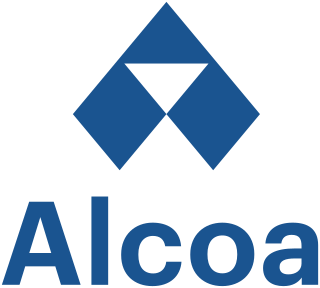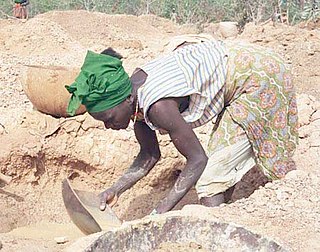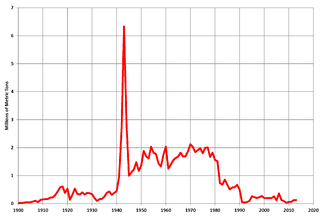Related Research Articles

Bauxite is a sedimentary rock with a relatively high aluminium content. It is the world's main source of aluminium and gallium. Bauxite consists mostly of the aluminium minerals gibbsite (Al(OH)3), boehmite (γ-AlO(OH)) and diaspore (α-AlO(OH)), mixed with the two iron oxides goethite (FeO(OH)) and haematite (Fe2O3), the aluminium clay mineral kaolinite (Al2Si2O5(OH)4) and small amounts of anatase (TiO2) and ilmenite (FeTiO3 or FeO.TiO2). Bauxite appears dull in luster and is reddish-brown, white, or tan in color.

Guinea, officially the Republic of Guinea, is a west-coastal country in West Africa. Formerly known as French Guinea, the modern country is sometimes referred to as Guinea-Conakry to distinguish it from other countries with "Guinea" in the name and the eponymous region, such as Guinea-Bissau and Equatorial Guinea. Guinea has a population of 12.4 million and an area of 245,857 square kilometres (94,926 sq mi).

Alcoa Corporation is an American industrial corporation. It is the world's eighth largest producer of aluminum, with corporate headquarters in Pittsburgh, Pennsylvania. Alcoa conducts operations in 10 countries. Alcoa is a major producer of primary aluminum, fabricated aluminum, and alumina combined, through its active and growing participation in all major aspects of the industry: technology, mining, refining, smelting, fabricating, and recycling.

Rio Tinto Group is an Anglo-Australian multinational and the world's second largest metals and mining corporation, behind BHP, producing iron ore, copper, diamonds, gold and uranium. The company was founded in 1873, when a multinational consortium of investors purchased a mine complex on the Rio Tinto, in Huelva, Spain, from the Spanish government. Since then, the company has grown through a long series of mergers and acquisitions to place itself among the world leaders in the production of many commodities, including aluminium, iron ore, copper, uranium, and diamonds. Although primarily focused on extraction of minerals, Rio Tinto also has significant operations in refining, particularly for refining bauxite and iron ore. Rio Tinto has joint head offices in London and Melbourne.
Alumina Limited is a public company listed on the Australian Securities Exchange (ASX). It was formed in 2003 in a demerger from Western Mining Corporation, and is one of the top 100 companies on the ASX.

Newcrest Mining Limited is an Australian-based corporation which engages in the exploration, development, mining and sale of gold and gold-copper concentrate. It is Australia's leading gold mining company and its operations have expanded beyond Australia, for example Indonesia, thus becoming a prominent international mining corporation. Newmont Mining Corporation initially started the company as a subsidiary in 1966. The subsidiary became Newmont Holdings Pty Ltd. in 1980 and in 1990 acquired 100% of Australmin Holdings Ltd. taking the current name.

The Boké Region is located in western Guinea. It is bordered by the countries of Senegal and Guinea-Bissau and the Guinean regions of Kindia and Labé. Its capital is the city of Boké.
Alcoa World Alumina and Chemicals is a joint venture between Alumina Limited and Alcoa and is abbreviated to AWAC. AWAC's business is the mining of bauxite, the extraction of alumina and the smelting of aluminium. It has about 25% of the global alumina market. Alcoa acts as the day-to-day manager.
Aluminum Corporation of China Limited, is a Chinese company listed in Hong Kong and in New York. A multinational aluminium company, its headquarters are in Beijing, People's Republic of China. It is the world's second-largest alumina producer and third-largest primary aluminium producer.
Vedanta Resources Limited is a global diversified metals and mining company with its headquarters in London, England. It is the largest mining and non-ferrous metals company in India and has mining operations in Australia and Zambia and oil and gas operations in three countries. Its main products are Zinc, Lead, Silver, Oil & Gas, Iron Ore, Steel, Aluminium and Power. It has also developed commercial power stations in India in Odisha and Punjab.
Articles related to Guinea include:
Aluminium in Africa originates from bauxite, and within Africa is primarily found in Guinea, Mozambique and Ghana. Guinea is by far the biggest producer in Africa, and is a world leader in bauxite production.

United Company RUSAL, international public joint-stock company is the world's second largest aluminium company by primary production output. It was the largest until overtaken by China Hongqiao Group in 2015. UC RUSAL accounts for almost 9% of the world's primary aluminium output and 9% of the world's alumina production.

Sangarédi is a mining town and sub-prefecture in western Guinea, where bauxite is mined. The ore is shipped by a railway to the Atlantic coast port of Kamsar, 135km to the west. As of 2016, Sangarédi had a population of 81,736 people, an increase of around 5% in just two years from 2014 due to the expansion of the area's three bauxite mines and refinery by CBG which currently produces around 14,000,000 tonnes per year from Sangarédi.
The mineral industry of Africa is the largest mineral industries in the world. Africa is the second largest continent, with 11.73 million miles of land, which implies large quantities of resources. With a population of 1.216 billion living there. For many African countries, mineral exploration and production constitute significant parts of their economies and remain keys to economic growth. Africa is richly endowed with mineral reserves and ranks first or second in quantity of world reserves of bauxite, cobalt, industrial diamond, phosphate rock, platinum-group metals (PGM), vermiculite, and zirconium.

Guinea has 1,086 km of railways. This includes 279 km at 1,435 mm gauge and 807 km at 1,000 mm gauge. The latter includes 662 km in common carrier service from Kankan to Conakry.

Bauxite mining in Australia is an economically significant industry both for Australia and globally. The industry focuses on the mining of bauxite, the primary raw material for alumina and aluminium. Australia is the world’s bauxite producer, producing almost a third of global bauxite.

According to the United States Geological Survey, Vietnam is estimated to hold the world's third-largest bauxite ore reserves, after Guinea and Australia. The majority of Vietnam's reserves are located in the Central Highlands and have only been minimally mined. Bauxite is typically strip mined and is used to produce aluminum. According to estimates by Vietnam's Ministry of Industry and Trade, Vietnam's reserves in the Central Highlands amount to 5.4 billion tons. Despite its large reserves, Vietnam produces only 30,000 tons of bauxite per year.

The mining industry of Guinea was developed during colonial rule. The minerals extracted consisted of iron, gold, diamond, and bauxite. Guinea ranks first in the world in bauxite reserves and 6th in the extraction of high-grade bauxite, the aluminium ore. The mining industry and exports of mining products accounted for 17% of Guinea’s gross domestic product (GDP) in 2010. Mining accounts for over 50% of its exports. The country accounts for 94% of Africa’s mining production of bauxite. The large mineral reserve, which has mostly remained untapped, is of immense interest for international firms.

Bauxite mining in the United States produced an estimated 128,000 metric tonnes of bauxite in 2013. Although the United States was an important source of bauxite in the early 20th century, it now supplies less than one percent of world bauxite production.
References
- ↑ Thomas O'Toole, Historical Dictionary of Guinea, 1978, p. 34
- ↑ Archived 2006-10-15 at the Wayback Machine See map. Archived 2007-03-11 at the Wayback Machine